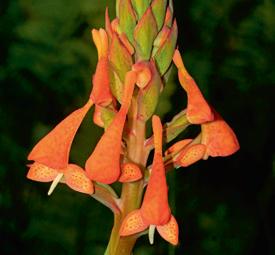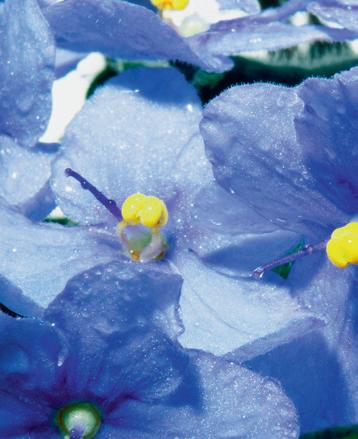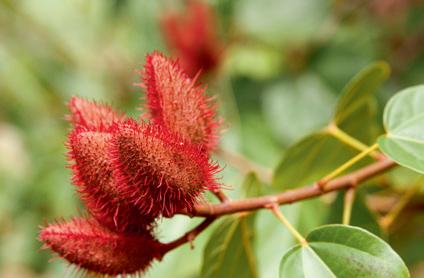
5 minute read
PLAN YOUR PLANT SAFARI
Tanzania’s Big Five wildlife thrills may grab the headlines, but the country’s flora is the match of its fauna. From the alien-like giant groundsel that grows on the upper reaches of Kilimanjaro to delicate African violets in the cloud forests of Udzungwa National Park, Tanzania contains amazing plants you won’t find growing wild anywhere else in the world. We hope this guide plants the seed of an idea for your own flora safari.
GIANT GROUNDSEL
(Dendrosenecio kilimanjari)
Part of the wonder of climbing Mount Kilimanjaro is moving through its five distinct climate zones, which become ever more alien in their landscape the higher you get. As the highest mountain in Africa, Kilimanjaro is an incubator for isolated, mutated, or rare species found almost nowhere else. Among the most striking of these species is the giant groundsel varietal Dendrosenecio kilimanjari. These bizarre looking plants – something between a cactus and a pineapple – can grow up to seven metres in height. You don’t have to summit the mountain to find them as they grow among the silvery glaciers and rocky ridges of the Shira Plateau at an elevation of around 3,962 metres.
RED HOT POKER
(Kniphofia)
Any plant safari in Tanzania should include the ‘Serengeti of Flowers’, the Kitulo Plateau. This protected area of grassland nestled between the peaks of the Kipengere, Poroto and Livingstone Mountains in the Southern Highlands erupts into a riotous wildflower display during the main rainy season of late November to April. The scale and diversity are breathtaking with more than 350 species of vascular plants to be found, 30 of them endemic to southern Tanzania. Visitors can wander among varieties of aloes, protea, geraniums, giant lobelias, lilies and aster daisies, but one plant that really sets the plateau ablaze is the red hot poker with its incredibly impressive, long and densely packed spikes of fiery orange flowers. This African native species is all over the plateau.

Red Hot Poker, The ‘Serengeti of Flowers’
DISA ROBUSTA ORCHID
The Kitulo Plateau is also renowned for its orchids, with 45 varieties of the fragrant and colourful flower showcased during the rainy season. Of those, 31 are endemic to Tanzania and 16 can be found in Kitulo or the surrounding Poroto Mountains. No wonder locals refer to the plateau as Bustani ya mungu, which is Swahili for God’s Garden. Among the native orchids is Disa Robusta. With its delicate tower of scarlet blooms, it is one of the most beautiful sights on the plateau, but also one of the rarest. Its scarcity is in part due to its carbohydrate-rich tuberous root being a key ingredient in local delicacy chikanda, a popular savoury snack.

The Disa Robusta orchid
LAKE LATUMBA CORAL TREE
This beautiful crimson flowered tree is so rare that it has twice been thought to be extinct. However, its rediscovery in 2014 and the subsequent successful growth of saplings have led to its revival. It remains critically endangered, but you may be lucky enough to spot the tell-tale spiny trunk and red flowers of one of the less than 50 mature examples to be found amid Tanzania’s coastal forests.
AFRICAN VIOLET
(Saintpaulia ionantha)
The Udzungwa Mountains of south-central Tanzania has been called the African Galapagos due to its raft of endemic animals and plants. Among the flora, its most famous native is the African violent. While the delicate, beautiful flower has become a popular houseplant all around the world, Tanzania is where it originated and still grows in the wild. There is an excellent network of trails to explore the cloud forest here, which rises to an altitude of 2,000 metres, which will bring you to highlights such as Sanje Waterfall, which plunges 170 metres into the forest valley and whose sheltered, damp conditions are ideal for the African violet sightings.

African Violet, native to Tanzania
FLAME TREE
(Delonix regia)
This flowering plant that is part of the Fabaceae bean family has leaves that bloom a rich red for beautiful, flamboyant displays. It’s also known as the flamboyant tree and royal Poinciana, but in Tanzania it’s popularly known as the ‘Christmas tree’ as this blaze of colour occurs in December. It’s a spectacular sight across the country and there’s no need for tinsel or fairy lights, these decorations are all natural.
BAOBAB
(Streptosiphon)
The Baobab tree is an iconic symbol of Africa. There are gigantic examples in the Tanzanian savannah that have stood there for centuries. You’ll know when you see one as they are singular-looking trees, Emerging thick from the earth, the Baobab’s sparse branches and thick trunk resembles the roots of a tree rather than the foliage. As a result, they are often called the ‘Upside Down Tree’. Another apt name is ‘The Tree of Life’. The baobab blossoms with fruits and flowers every nine months. Both are consumed by humans and animals, providing a source of food during droughts. Research has shown the tree’s fruit is a superfood with four times more vitamin C than an orange, six times more potassium than a banana, twice as much magnesium as an avocado and more calcium than milk. On top of that the Baobab’s bark provides a source of moisture for many mammals during the dry season, a scratching post for itchy elephants and rhinos and a refuge from predators for bats, birds and rodents.
ACACIA
(Acacia tortillis)
Another regular safari spot is the Acacia tree with its umbrellalike branches. East Africa has around 62 species of which six are endemic to Tanzania. While grabbing a souvenir photo next to one of these icons of the African bush is a must, the tree does try its best not to allow anyone to get too close. The first thing you will notice is its thorns – acacias are often referred to as thorn trees – which are designed to deter herbivores feeding on their leaves. Even more ingenious is that some acacia trees release tannin when animals such as giraffe approach for a nibble. The toxin is dangerous if ingested and will prompt the giraffe to move on. The chemical defence system doesn’t end there with the trees also releasing ethylene. The gas, which has a sweet and musky odour, can travel up to 40 metres, acting as a warning system to other trees of approaching animals. Yes, that’s right, these trees talk to each other.

Symbol of Africa – the baobab tree
LIPSTICK TREE
(Annatto Bixa)
You’ll find plenty of these small trees (sometimes a shrub) in Zanzibar. It gets its name because the seeds the tree produces are often used in the creation of red lipstick, as well as spices and body paint. The natural red condiment the tree produces is called annatto, and it is gathered from the wax that covers the tree’s seeds. These seeds are used in a lot of traditional dishes all over Zanzibar.

The fruit of the lipstick tree









